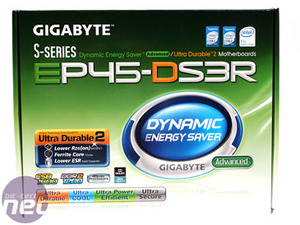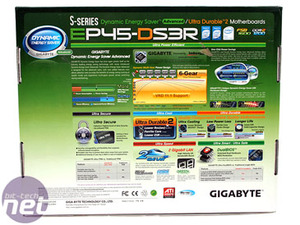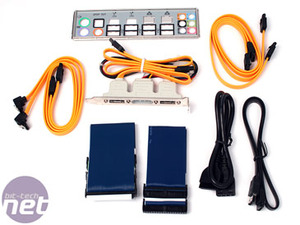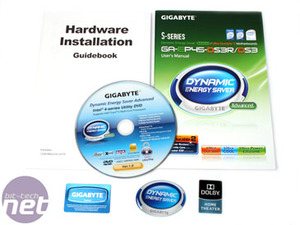Manufacturer: Gigabyte
UK Price (as Reviewed): £86.72
US Price (as Reviewed): $146.97
The Gigabyte GA-P35-DS3R of last year was one of the favourites among enthusiasts looking for a bargain. After a few BIOS revisions it turned into a very overclockable, reasonably featured board suitable for those looking to use a single graphics card. In hindsight when we reviewed it just 12 months ago it was just too early to take advantage of future BIOS' and with that in mind we've sat back and waited for the latest P45 platform to mature slightly. After all, our initial P45 coverage was significant enough to wet the appetites of many, but it was apparent the new chipset was a difficult lion to tame.
Gigabyte uses an "E" prefix to denote "energy efficient" hardware, dynamically regulating the amount of power phases being used depending on CPU load. This feature came into existence at the start of the 2008 for Intel motherboards only. This was revamped at the launch of P45 to become the Dynamic Energy Saver Advanced after initial feedback from users and reviewers wanting new features was taken on board.
If you're hankering after a Gigabyte DS3 board there is more choice than you can shake a PCB at. They come in no less than six varieties: EP45-DS3 (vanilla), EP45-DS3L (single PCI-Express x16), EP45-DS3P (three PCI-Express x16), GA-EP45T-DS3R (DDR3 only), EP45C-DS3R (DDR2 and DDR3 combo), and the EP45-DS3R (two PCI-Express x16 and DDR2) which we are reviewing here, not to mention the DS4, DS5, DQ6 and Extreme models that gently scale the feature and cost curve.
Gigabyte knows how to make a SKU-range to satisfy everyone, that's for sure.
We believe EP45-DS3R should satisfy our readers since inexpensive, performance DDR2 should match with it nicely, and as ATI has finally made some desirable, well-priced graphics cards the pair of PCI-Express 2.0 x16 (at x8 bandwidth) lanes should suit a pair of Radeon HD 4800-series cards nicely.
However, does Gigabyte make a board to rival the capable competition from Asus' P5Q-E, the MSI P45 Neo3-FR, or even the DFI DK P45-T2RS?
Case badges are so old hat, now it's just a bunch of random sized stickers to put anywhere you like, it seems. Naturally we like the clippy-connectors on the SATA cables to prevent them from falling out, and even the pair of 90 degree ones are a great inclusion for keeping cables neat.
As usual Gigabyte includes a SATA to eSATA bracket for fast, external storage duties which means you lose one or two internal ports, however we still maintain we prefer this choice, especially as it means we don't have to put up with craptacular JMicron eSATA controllers that everyone else insists on using.
The manual is decent and the hardware installation guide is a nice touch, but the real bonus is the driver disk which presents a very modern interface and it's one click installation works extremely well - exactly what you need. Yes, I know, I'm commenting about a driver disk but Gigabyte has one of the best we've seen to date so we thought it was worth a footnote at the bottom of the page.
UK Price (as Reviewed): £86.72
US Price (as Reviewed): $146.97
Introduction
I'll happily admit that I prefer not to drop more than £100 on a motherboard. Like many of you, I find the features of super expensive boards become ever more obscure and diminishing in value - do I need four Ethernet ports and 6-squillion front side bus? Not really, just a decent overclock and something stable with a good layout that has the essential features right. Considering that something new will inevitably be tempting us in a quarter/six months/a years time, getting the most value for money is a prerequisite of almost every purchase, computing or not.The Gigabyte GA-P35-DS3R of last year was one of the favourites among enthusiasts looking for a bargain. After a few BIOS revisions it turned into a very overclockable, reasonably featured board suitable for those looking to use a single graphics card. In hindsight when we reviewed it just 12 months ago it was just too early to take advantage of future BIOS' and with that in mind we've sat back and waited for the latest P45 platform to mature slightly. After all, our initial P45 coverage was significant enough to wet the appetites of many, but it was apparent the new chipset was a difficult lion to tame.
Gigabyte uses an "E" prefix to denote "energy efficient" hardware, dynamically regulating the amount of power phases being used depending on CPU load. This feature came into existence at the start of the 2008 for Intel motherboards only. This was revamped at the launch of P45 to become the Dynamic Energy Saver Advanced after initial feedback from users and reviewers wanting new features was taken on board.
If you're hankering after a Gigabyte DS3 board there is more choice than you can shake a PCB at. They come in no less than six varieties: EP45-DS3 (vanilla), EP45-DS3L (single PCI-Express x16), EP45-DS3P (three PCI-Express x16), GA-EP45T-DS3R (DDR3 only), EP45C-DS3R (DDR2 and DDR3 combo), and the EP45-DS3R (two PCI-Express x16 and DDR2) which we are reviewing here, not to mention the DS4, DS5, DQ6 and Extreme models that gently scale the feature and cost curve.
Gigabyte knows how to make a SKU-range to satisfy everyone, that's for sure.
We believe EP45-DS3R should satisfy our readers since inexpensive, performance DDR2 should match with it nicely, and as ATI has finally made some desirable, well-priced graphics cards the pair of PCI-Express 2.0 x16 (at x8 bandwidth) lanes should suit a pair of Radeon HD 4800-series cards nicely.
However, does Gigabyte make a board to rival the capable competition from Asus' P5Q-E, the MSI P45 Neo3-FR, or even the DFI DK P45-T2RS?
Box Contents
- Four clip-locking SATA cables, two of which have 90 degree connectors
- SATA to eSATA PCI bracket and cables
- IDE and floppy cable
- Metal rear I/O bracket
- Driver disk, manual and hardware installation guide
- Dolby Home Theatre, Gigabyte Dynamic Energy Saver and Gigabyte stickers
Case badges are so old hat, now it's just a bunch of random sized stickers to put anywhere you like, it seems. Naturally we like the clippy-connectors on the SATA cables to prevent them from falling out, and even the pair of 90 degree ones are a great inclusion for keeping cables neat.
As usual Gigabyte includes a SATA to eSATA bracket for fast, external storage duties which means you lose one or two internal ports, however we still maintain we prefer this choice, especially as it means we don't have to put up with craptacular JMicron eSATA controllers that everyone else insists on using.
The manual is decent and the hardware installation guide is a nice touch, but the real bonus is the driver disk which presents a very modern interface and it's one click installation works extremely well - exactly what you need. Yes, I know, I'm commenting about a driver disk but Gigabyte has one of the best we've seen to date so we thought it was worth a footnote at the bottom of the page.

MSI MPG Velox 100R Chassis Review
October 14 2021 | 15:04













Want to comment? Please log in.